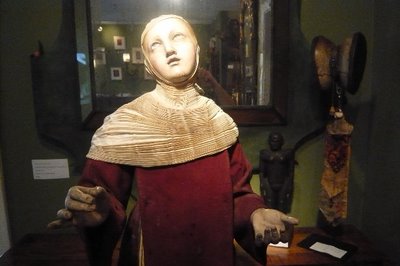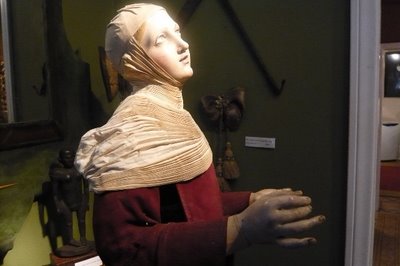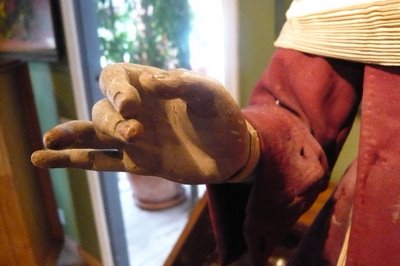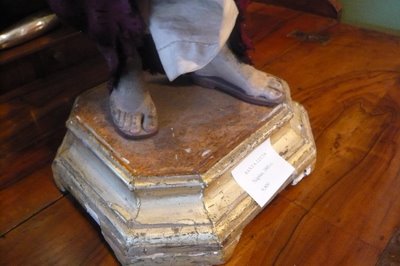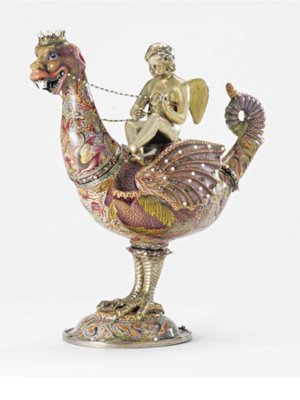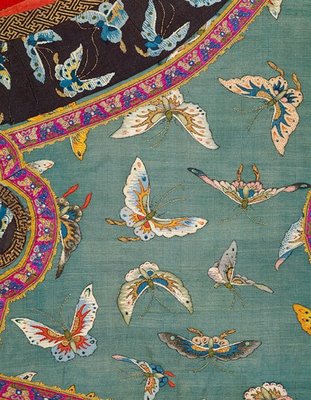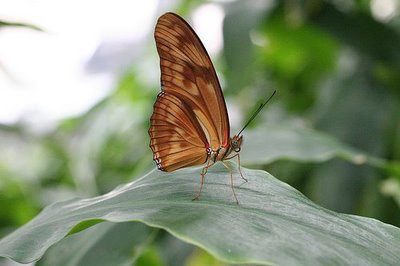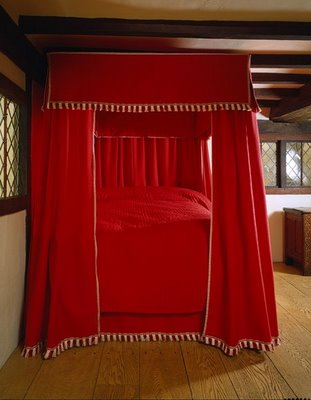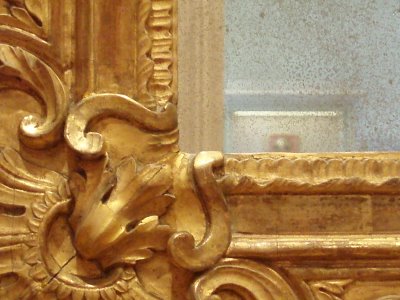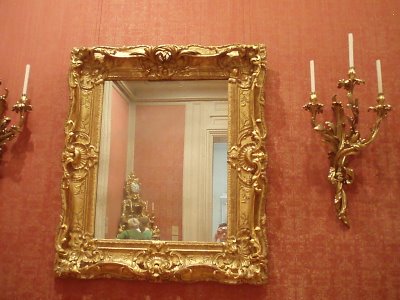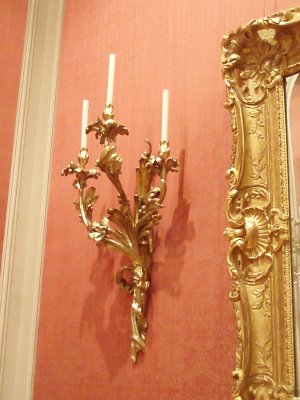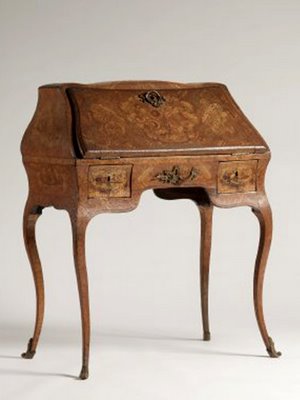Posts from the ‘object’ Category
This statue from Naples c 1750 of Santa Lucia is carved and polychromed wood with sulphur eyes dressed in the original cloth robe. Sometimes she is depicted carrying a tray with two eyes on it.
Saint Lucy lived in Syracuse, Sicily in the early 4th century. Her mother decided to marry Lucy off to a Pagan, which did not make Lucy happy. She told her mother that Christ would make a much better partner and she cured her mother of a long illness which convinced her. She got out of the marriage. This did not please her no longer soon-to-be-husband who gave her up to the authorities for loving Jesus. She was arrested and thrown off to become a prostitute. She refused and was killed by soldiers after her eyes were plucked out. Her vision was later restored by God. There seems to be a lesson to learn from all of this.

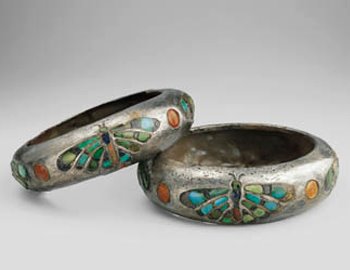
While it seems to be good to get what one desires, the greatest good is not
to desire what one does not need.


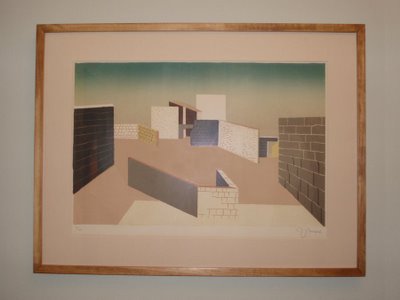 The image at top is Lurcat’s,”Paysage à Smyrne, l’arbre mort,” 1926. Now at the St. Louis Museum of Art. Below it is my Lurcat lithogaph purchased at a flea market in Florida. The paintings title is translated as something like, Dead tree in the landscape at Smyrne.
The image at top is Lurcat’s,”Paysage à Smyrne, l’arbre mort,” 1926. Now at the St. Louis Museum of Art. Below it is my Lurcat lithogaph purchased at a flea market in Florida. The paintings title is translated as something like, Dead tree in the landscape at Smyrne. Acanthus as an ornamental motif developed not from nature, but from precedent. The motif developed from craftsperson to craftsperson changing over time and stylized far from the actual leaf, Acanthus mollis.
This frame at the Getty is a fine example of the Acanthus motif.– made by Jean Chérin.
Chérin was unusual because he was one of two who were Guild member of carpenters’ and cabinet makers’ in the mid 1700’s–unusual because dues were high and apprentice time was long. But this is how the frame is identified as it should be stamped on the back with his mark from both guilds.
Update 8/21/12. Book recommendations:
I am slowly starting to furnish my imaginary home. I’m not sure where I’ll place my new desk, but I had to get it. Bachelard in The Poetics of Space wrote something about that when we think of home, we have an idealized imaginary home in our minds, and if we try to leave this place to have it built, it moves into the area of a psychological project. Can’t you imagine running your fingers along my desk’s lovely curves? Opening a drawer for a paper clip? I think my little lap top fits nicely. I must find a chair, sit up straight, and not cross my legs.
Desk, France, 18th century 1750-1775.
Gertrude 101: “Everybody gets so much information all day long that they lose their common sense.”
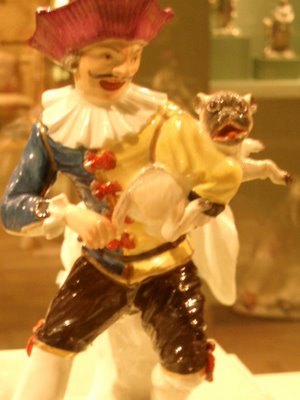 1740. Harlequin and Pug as Hurdy-Gurdy. His Face!
1740. Harlequin and Pug as Hurdy-Gurdy. His Face!
 c.1750 Italian. The Alchemist & his Assistant.
c.1750 Italian. The Alchemist & his Assistant.
 Orientals with an Artichoke as a Perfume Burner. Model by Johann Friedrich Luck. German, Frankenthal, ca. 1766.
Orientals with an Artichoke as a Perfume Burner. Model by Johann Friedrich Luck. German, Frankenthal, ca. 1766.
 Indiscreet Harlequin. Model 1740. The shoes!
Indiscreet Harlequin. Model 1740. The shoes!
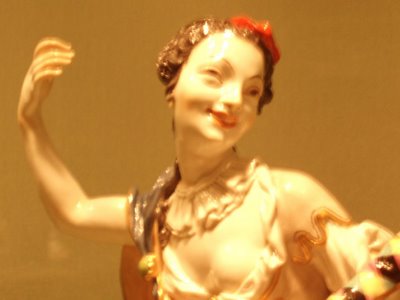 The Muse Thalia with Infant. Model after Johann Joachim Kändler (1706-1775).
The Muse Thalia with Infant. Model after Johann Joachim Kändler (1706-1775).
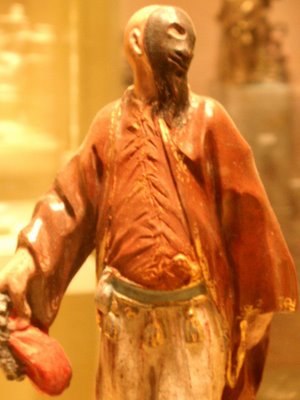 Pantaloon. Meissen. Böttger period. (1710-1719).
Pantaloon. Meissen. Böttger period. (1710-1719). 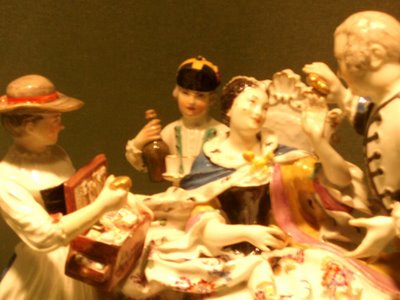 The Trinket Seller. Meissen. After a model 1738. Johann Joachim Kändler (1706-1775).
The Trinket Seller. Meissen. After a model 1738. Johann Joachim Kändler (1706-1775). After several years, Böttger finally figured out how to make a dark red colored porcelain-like material. A step in the right direction so they set up a factory in 1710. Johann had a bit of an epiphany around 1713 and tried making porcelain out of his hair powder which worked. Everyone was happy although I’m not sure what happenend to Johann.
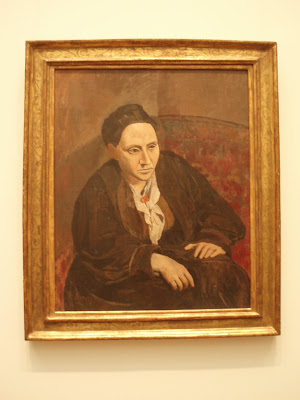
A CUTLET. A blind agitation is manly and uttermost.
–Tender Buttons. Objects, 1914.
My friend Mr. RM of West Palm Beach once told me he thought that Alice B. wrote the Autobiography of Alice B. Toklas and not Gertrude Stein, as Stein’s works are incomprehensible and The Autobiography is not.
I’ve always enjoyed reading about authors rather than reading their work. Gertrude Stein was my first favorite person to read about. She said things of which I had never heard. “It takes a lot of time to be a genius, you have to sit around so much doing nothing, really doing nothing.” It thrilled me. This, Picasso’s portrait, was on the cover of one of my favorite biographies that I read in high school. I used to stare at the cover; imagining it. It became a symbol for me of, that which was beyond where I was, so when wandering through the MET ten years ago I came across the portrait, it surprised me. It was not unlike one of Thoreau’s deers in the woods.
See portrait in situ here.
I still like to sport a Gertrude haircut and I still fantasize about having a suit made out of brown corduroy and taking up with socks and sandals for long walks around Paris (It is not what France gave you but what it did not take from you that was important). The title of this post is Stein. The rest of the quote is, “If you do not enjoy it, why do you make a fuss about it?” My new motto. You can hear the interview from 1934 here.

